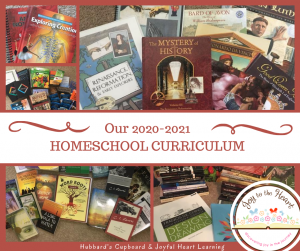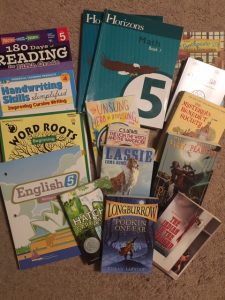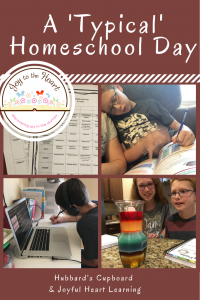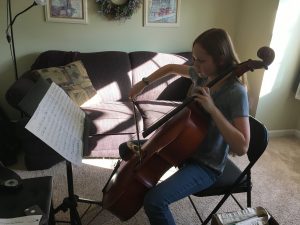I truly feel that embracing the homeschool lifestyle has helped to create a strong bond among all of our children. They’ve always been there for each other, supported one another through the highs and lows, and truly have been each other’s best friends and cheerleaders. So, as our family begins to think about another new school year, there’s a twinge of sadness, but also great expectation — Our oldest daughter graduated from our homeschool in May and is heading off to college in the fall! We are so excited for her as she begins this new journey in her life, but we will all greatly miss her joyful spirit, hugs, insights, and, simply, being with her each day. I’m thankful for the ability to text, FaceTime, etc. as I know all of the kids will want to continue to keep in close contact with their big sister – one of their very best friends.
As our oldest prepares for moving to a dorm and beginning life and academics at college, our own planning for a new school year at home continues as well. Below are our curriculum choices for 5th, 7th, 9th, and 11th grades this coming year!
ELEMENTARY
- Reading / Literature:
— 180 Days of Reading Grade 5
— Literature Books – Chronicles of Narnia – The Lion the Witch and the Wardrobe, Lassie, The Unsung Hero of Birdsong USA, The Indian in the Cupboard, Twenty One Balloons, The Mysterious Benedict Society, Hatchet, The Toothpaste Millionaire, LongBurrow series (Podkin One-Ear), and Peter and the Starcatchers - Spelling/Vocabulary: Beginning Word Roots, Word Ladders
- Handwriting: Handwriting Skills Simplified E: Cursive Writing; Draw Write Now (cursive and print)
- Writing/Grammar/Composition: BJU English 5
- Math: Horizons 5 (and moving into 6)
- Art: 1-2 times per month instruction as part of our co-op
- Bible: Awana T&T, daily Bible Reading
- Additions: Trail Life (Mountain Lion)
MIDDLE SCHOOL
Our 7th Grader…
- Reading/Literature:
— Reading, studying, and participating in a once a month book club using the following books – Fever 1793, Sweep, A Long Walk to Water, Music of Tigers, The Bridge Home, Journey to the River Sea, Anne of Green Gables, and Harbor Me
— Veritas Press Omnibus 1, Secondary self paced online lessons with reading and comprehension of the following books – Chosen by God, Till We Have Faces, The Magician’s Nephew, The Lion, the Witch & the Wardrobe, The Horse and His Boy, Prince Caspian, The Voyage of the Dawn Treader, The Silver Chair, The Last Battle, The Best Things in Life, Unaborted Socrates, The Eagle of the Ninth, The Screwtape Letters, The Holiness of God - Writing/Grammar/Composition: Foundations of Composition (online, live class) including Jensen’s Punctuation for grammar, Sentence Composing for Middle School, Word Roots 3
- Math: Saxon 8/7
- Bible: Awana/Trek, daily Bible Reading
- Art: 1-2 times per month instruction as part of our co-op
- Additions: gymnastics, ballet, writing/editing a novel
5th & 7th GRADE ‘TOGETHER’ SUBJECTS
- Science: Apologia Exploring Creation with Human Anatomy and Physiology (with hands on science experiments at our co-op)
- Social Studies: The Renaissance, Reformation, and Early Explorers using Mystery of History 3 (with a homemade notebook)
HIGH SCHOOL
Our 9th Grader…
- English 9: Classic Literature/ Literary Analysis and Composition
(live, online course) – Romeo and Juliet, The Prince and the Pauper, Our Town, King Arthur: Tales from the Round Table, Silas Marner, The Giver, The Scarlet Letter, Up From Slavery, The Importance of Being Earnest; Easy Grammar Ultimate Grade 10 - Algebra 2 with Integrated Geometry: Shormann Algebra 2
- Biology: Apologia Exploring Creation with Biology
- World Geography: North Star Geography by Bright Ideas Press
- World Religions & Cultures: But Don’t All Religions Lead to God?, World Religions: An Indispensable Introduction, Mimosa, Listening to the Language of the Bible, Sitting at the Feet of Rabbi Jesus, Sundar Singh: Footprints Over the Mountains, Queen of the Dark Chamber, Jacob Deshazer: Forgive Your Enemies, I Dared to Call Him Father, God’s Global Mosaic, Foreign to Familiar, iWitness Heresies and Cults
- Spanish 1: BJU 1 (in conjunction with a live, online course)
- Intro to Architecture: Design Drawing by Francis Ching (in conjunction with a live, online course)
- Physical Education & Health: Apologia Exploring Creation with Health & Nutrition, walking/running, indoor exercise
- Additions: AWANA Journey
Our 11th Grader…
- English 11: American Literature and Composition
(live, online course) –Sinners in the Hands of an Angry God and Other Puritan Sermons, The Autobiography of Benjamin Franklin, Young Goodman Brown and Other Short Stories, The Raven and Other Favorite Poems, The Gold Bug and Other Tales, Evangeline and Other Poems, Humorous Stories and Sketches, 12 Years a Slave, The Red Badge of Courage, The Road Not Taken and Other Poems, The Great Gatsby, The Old Man and the Sea, The Pearl, My Antonia - American History: Notgrass Exploring America
- PreCalculus: Shormann PreCalculus
- Spanish 4: Homeschool Spanish Academy
- Introduction to Computer Science: Computer Science Principals: The Foundational Concepts of Computer Science and various videos from online resources, including Crash Course Computer Science and Crash Course Navigating Digital Information
- Graphic & Web Design: Web Design with HTML, CSS, JavaScript and JQuery by Jon Duckett (in conjunction with a live, online course)
- Physical Education & Health: Apologia Exploring Creation with Health & Nutrition, walking/running, indoor exercise
- Instrumental Music 3: Cello lessons, Piano Lessons, Member of the local youth orchestra
- Additions: AWANA Journey, beginning a local cake business, SAT prep, career assessments
ALL TOGETHER
- Bible Devotions: Bible, The Most Important Thing You’ll Ever Study: A Survey of the Bible (oral)
Praying for a productive, joy-filled, relationship strengthening, and gospel centered year of learning for our family – whether at home or away!
__________________________________________
Would you like to see our curriculum choices from previous years?
2019-2020 (12th, 10th, 8th, 6th, 4th)
2018-2019 (11th, 9th, 7th, 5th, 3rd)
2017-2018 (10th, 8th, 6th, 4th, 2nd)
2016-2017 (9th, 7th, 5th, 3rd, 1st)
2015-2016 (8th, 6th, 4th, 2nd, Kindergarten)
2014-2015 (7th, 5th, 3rd, 1st, PreK)
2013-2014 (6th, 4th, 2nd, K, preschool)
2012-2013 (5th, 3rd, 1st, PreK, 2 year old)
2011-2012 (4th, 2nd, K, 3’s preschool, toddler)
2010-2011 (3rd, 1st, PreK, 2 year old, 4 month old baby)
2009-2010 (2nd, K, 3’s preschool, toddler, baby arrived end of year)
2008-2009 (1st, PreK, 2 year old, 6 month old baby)
2007-2008 (K, 3’s preschool, toddler, baby arrived mid year)
2006-2007 (PreK, 2 year old, 7 month old baby)
– Joyful Heart Character
2005-2006 (3’s preschool, toddler, baby arrived mid year)
– Joyful Heart Bible and Rhyme
2004-2005 (2 year old, 6 mo old baby)
– Joyful Heart Learning























